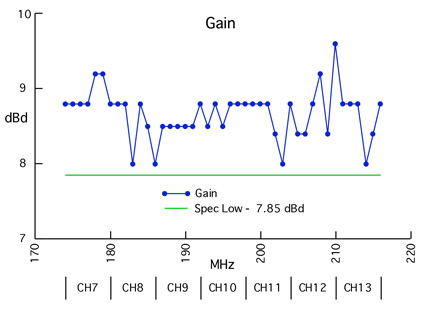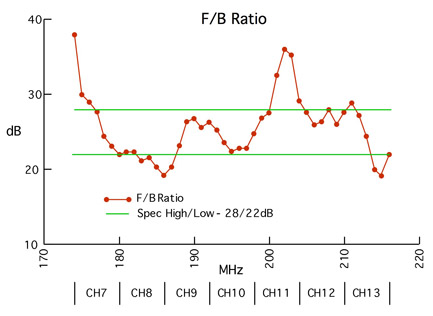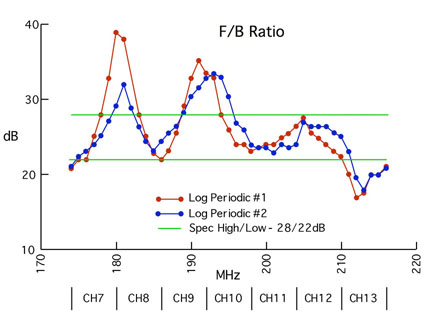
One might wonder what's the point in building an antenna like this when you can buy a very similar antenna from Winegard or Antennacraft. For the majority of the people needing a channel 7-13 antenna there probably is no point. Those antennas are good enough.
I'm in a very poor location for TV reception with severe multipath and I need an antenna with a good pattern and high F/B ratio. I tried a Winegard YA-1713 but it didn't meet my needs. The LP looked like it might be better so I decided to give it a try.
Another reason to build an antenna is that some people just like to build things and there is little associated with HDTV that you can build.
Below are some tests I ran on the LP and Winegard YA-1713. I can't make any guarantees how accurate the data is. I did what I could. I don't have an antenna test range. My test equipment is a Fluke 6062A signal generator and a Tektronix 495P spectrum analyzer. I made a dipole that I adjusted to the center frequency of channels 7-13 for some tests.
I'm a little disappointed at the fall off in peformance of the LP on channel 13 although it is not terrible. The design needs to be run through an antenna modeling program and tweaked for improvements at the high end. In my case channel 13 is not a critical channel after the transition so the antenna is good enough and it's quite good on channels 9 and 10 where I'll need it.

Figure 1 is the Front-to-back ratio test. I tuned the dipole to middle of channel 10. The dipole and the LP were about 5' off the ground, about 30' apart, and pointed at each other. I took power measurements at 1 Mhz steps from 174 to 216 Mhz. Then I rotated the antenna to the back and repeated the measurements. The graph shows the difference between the two sets of measurements for both LPs I built. It's useful to mention that the front response of the two antennas tracked to about 0.5dB across the band. Based on this I decided to take only one set of gain measurements.
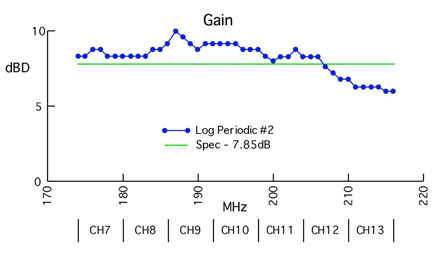
Figure 2 shows the gain of the second LP. This time I used a Winegard YA-1713 as the tramitting antenna. I started by taking received signal measurements in 1 Mhz steps using the dipole as the antenna except I adjusted the length of the dipole for the center of each channel. I also verified that when I changed lengths, the power measurement stayed the same so there were no discontinuties from channel to channel. Then I replaced the dipole with the LP and repeated the tests. The 2 pieces of coax I used were within .05 dB of the same loss at 200Mhz which I figured was good enough since the spectrum analyzer resolution is 0.4 dB. There are other variables that I can't account for but this is the best I can do.
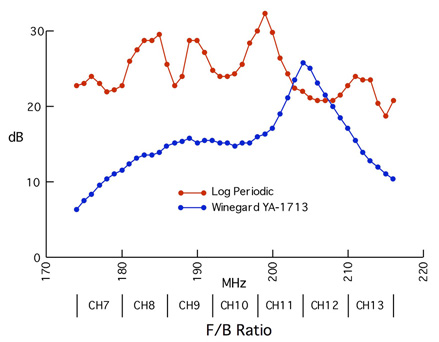
Figure 3 shows a test I ran this test between my prototype LP (3/4" boom instead of 1/2" boom, otherwise the same) and a Winegard YA-1713. Certainly the LP is much better in this test than the Winegard.
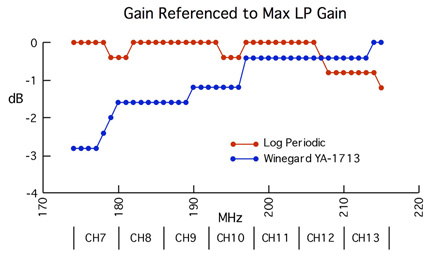
I went to 2 LPs because I knew my location was so poor that one antenna wouldn't be reliable. After a week in the air, even 2 antennas are not 100% but they are better. There are times when the signals drop so much that I don't think any antenna would be good enough. Still, two are better than one. I get a deep null at +/- 15 degrees with the pair compared to no null with just one. A single antenna didn't drop by 10 dB until +/- 45 degrees and simply had one broad lobe. I had one YA-1713 up for a couple of weeks and the mutipath on the local stations was bad all the time.
The LP pair has given me enough rejection on two local analog stations to allow me to receive two distant digital stations that are off pointed about 70 degrees on the same channels. This did not happen with one antenna.
My conclusion is that the LP is better than the Winegard YA-1713 in marginal conditions but it can't perform miracles. It can't turn no reception into perfect reception. It can probably turn partial reception into better reception. The peformance on the tower of the LP over the YA-1713 seems to reflect the on ground measurements.
I extended the boom and added 2 elements to the prototype LP to see how that would affect the gain and F/B ratio on channel 13 since both were low there. The results are below.
